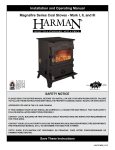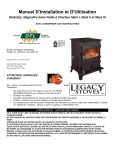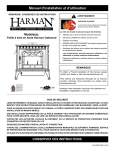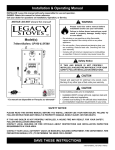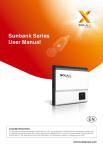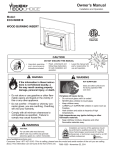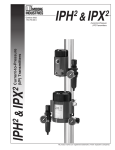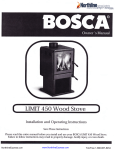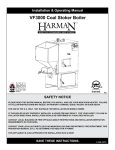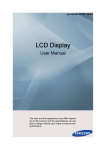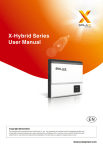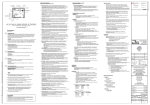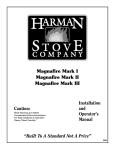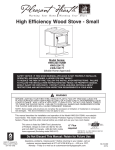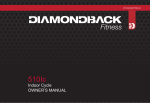Download Installation and Operating Manual
Transcript
Installation and Operating Manual NOTICE: SAVE THESE INSTRUCTIONS ! WARNING HOT SURFACES! Glass and other surfaces are hot during operation and cool down. Model(s): Magnafire Series Coal Stoves Mark I and Mark III Hot glass will cause burns. • Do not touch glass until it is cooled • NEVER allow children to touch glass • Keep children away • CAREFULLY SUPERVISE children in same room as stove. • Alert children and adults to hazards of high temperatures. High temperatures may ignite clothing or other flammable materials. • Keep clothing, furniture, draperies and other flammable materials away. SAFETY NOTICE PLEASE READ THIS ENTIRE MANUAL BEFORE YOU INSTALL OR USE YOUR NEW ROOM HEATER. FAILURE TO FOLLOW THESE INSTRUCTIONS MAY RESULT IN PROPERTY DAMAGE, BODILY INJURY, OR EVEN DEATH. APPROVED FOR USE IN THE U.S. AND CANADA IF THIS HARMAN® STOVE IS NOT INSTALLED CORRECTLY, A HOUSE FIRE MAY RESULT. FOR YOUR SAFETY, FOLLOW INSTALLATION DIRECTIONS PRECISELY. CONTACT LOCAL BUILDING OR FIRE OFFICIALS ABOUT RESTRICTIONS AND INSPECTION REQUIREMENTS FOR YOUR AREA. CONTACT YOUR LOCAL AUTHORITY (SUCH AS THE MUNICIPAL BUILDING DEPARTMENT, FIRE DEPARTMENT, FIRE PREVENTION BUREAU, ETC.) TO DETERMINE THE NEED FOR A PERMIT. CETTE GUIDE D’UTILISATION EST DISPONIBLE EN FRANCAIS. CHEZ VOTRE CONCESSIONNAIRE DE HARMAN® HOME HEATING. Save These Instructions 3-90-70746R13_03/14 3-90-70746R13_03/14 Introduction Thank you for purchasing a Harman® Magnafire coal stove. The Magnafire series has been designed and built to last. Whether you’re heating a room or heating your whole house, you’ve made the right choice. Please read this entire instruction manual before attempting to install or operate your new stove. If you have further questions regarding your new stove, contact your Harman® dealer. Follow these instructions and you will have many years of warmth and comfort enjoying your new coal stove. If you are a first-time coal burner, keep in mind that you will not have instant success with maintaining a fire. No one does. Following these instructions should help you with the basic principals. Please copy your serial number, from the label on the back of your stove, to the box below. Harman Mark Series Stove This appliance is also approved installation Label measures: 9.5" high Xfor8.5" wide into a shop. LISTED SOLID FUEL (COAL) FIREPLACE STOVE OR ROOM HEATER POÊLE (DE CHARBON) DANS UN FOYER OU APPAREIL DE CHAUFFAGE OMNI-Test Laboratories, Inc. Report #/Rapport #135-S-07-4 Tested to/Testé à: June 1985 UL 737-1996, UL 1482-1996, Meets requirements of ULC-S627-00/ Selon les exigences de ULC-S627-00 Certified for U.S.A. and Canada/Certifié pour les États-Unis et le Canada MODEL/Modèle: MARK I MARK II MARK III Serial No. No de série: CONTACT YOUR LOCAL BUILDING OFFICIALS ABOUT RESTRICTIONS AND INSTALLATION INSPECTION IN YOUR AREA/ CLEARANCE TO COMBUSTIBLE SURFACE *Not Tested - NFPA Guildlines BARCODE LABEL CONTACTEZ LE BUREAU DE LA CONSTRUCTION OU LE BUREAU DES INCENDIES AU DES RESTRICTIONS ET DE L’INSPECTION D’INSTALLATION DANS VOTRE VOISINAGE PREVENT HOUSE FIRES: Install and use only in accordance with manufacturer’s installation and operation instructions and local building codes. In absence of any local codes, installation must meet minimum requirements of NFPA 211 in USA. Refer to manufacturer’s instructions and local codes for precautions required for passing chimney through a combustible wall or ceiling. Inspect and clean chimney system frequently in accordance with manufacturer’s instructions. FOR USE WITH COAL ONLY. Don’t connect this stove to a chimney serving another appliance. Flue connector pipe must be 6” diameter, minimum 24 MSG black or 26 MSG blue steel. Chimney must be factory built 103HT or masonry. NOTE: Replace glass only with 5mm ceramic glass available from your dealer. Inspect and clean chimney frequently. Under certain condictions of use, creosote buildup may occur rapidly. DO NOT OVERFIRE - IF HEATER OR CHIMNEY CONNECTOR GLOWS, YOU ARE OVERFIRING. 33” 24” 42” 18” 8” 16” 18”* D B C A STOVE H D B PRÉVENTION DES FAUX DE MAISON: Installez et utilisez en accord avec les instructions d’installation et d’opération du fabricant et des codes locaux. S’il n’y a pas de codes lacaux. l’installation doit suivre kes exigences minimum de NFPA 211 aux États-Unis. Référez vous aux instructions du fabricant et des codes locaux pour les précautions pour passer une cheminée à travers un mur ou unplafond combustibles. Inspectez et nettoyez le systèm de chiminée fréquemment en accord avec les instructions du fabricant. UTILISER SEULEMENT DU CHARBON Ne pas connecter cet appareil à un tuyau de cheminée servant un autre appareil. Le tuyau connector doit être de 6” de diamètre, d’acier noir de minimum de 24 MSG ou d’acier bleu de 26 MSG. La cheminée doit être bâtit à l’usine de 103 HT ou faite en briques. Note: Remplacez la vitre seulement avec une vitre céramique de 5mm disponible chez votre fournisseur. Inspectez et nettoyez la cheminée fréquemment. Sous certaines conditions. il se peut que la créosote s’accumule rapidement. NE PAS SURCHAUFFER. SI L’APPAREIL DE CHAUFFAGE OU LE TUYAU DE CHEMINÉE ROUGISSENT. VOUS SURCHAUFFEZ. ESPACES LIBRES AUX COMBUSTIBLES BACKWALL SIDEWALL A - Unit to Sidewall B - Unit to Backwall C - Chimney Connector to Side Wall D - Chimney Connector to Back Wall E - Floor Protector, Side and Rear F - Floor Protector, Front H - Pipe conector to Ceiling 008 A - Du mur de côté à l’appareil B - Du mur arrière àl’appareil C - Du tuyau de cheminée au mur de côté D - Du tuyau de cheminée au mur arrière E - Du plancher protecteur, Côté arrière F - du plancher protecteur, Devant H - Du tuyau connecteur au plafond Floor protection must be a 3/8” min. thickness, non-combustible material or equivalent, extending beneath heater and to front/sides/rear as indicated on the diagram 33” 24” 42” 18” 8” 16” 18”* Leprotecteur de plancher doit être de 3/8” d’épaisseur minimum, fait de matière non combustible ou équivalent, s’étendant en dessous, en avant, en arrière et sur les côtés de l’appareil de chauffage comme indiqué sur le diagramme. *Pas testé - indications NFPA ELECTRICAL RATING: 115VAC, 60 HZ, 1.1 AMPS DANGER: Risk of electrical shock. Disconnect power supply before servicing. Route power cord away from unit. Do not route power cord under or in front of appliance. CAUTION: RISK OF EXCESSIVE TEMPERATURE AND DAMAGE TO UNIT. PROPER OPERATION REQUIRES THE USE OF ONLY PEA, NUT & COAL STOVE SIZE ANTHRACITE COAL CAUTION: HOT WHILE IN OPERATION. DO NOT TOUCH. KEEP CHILDREN AND CLOTHING AWAY. CONTACT MAY CAUSE SKIN BURNS. SEE NAMEPLATE AND INSTRUCTIONS. KEEP FURNISHINGS AND OTHER COMBUSTIBLE MATERIALS A CONSIDERABLE DISTANCE AWAY FROM THIS APPLIANCE. Exempt From EPA Certification under 40 CFR 60.531 Date of Manufacture / Date de fabrication 2012 2013 2014 JAN FEB MAR APR MAY JUN JUL AUG SEP OCT NOV DEC Appliance Certification. Test Lab: Omni-Test Laboratories Report #: 135-S-07-4 Standard(s): UL 1482-1996, UL 737-1996, ULC-S627-00 PUISSANCE ÉLECTRIQUE: 115VAC, 60 HZ, 1.1 AMPS DANGER: Il y a risque de choque électrique. Déconnectez le fil électrique avant le service Éloignez le fil électrique de l’appareil. Ne placez pas le fil électrique sous ou à l’avant de l’appareil. ATTENTION: IL Y A RISQUE DE TEMPÉRATURES EXCESSIVE ET DE DOMMAGE À L’APPAREIL. UN BON FONCTIONNEMENT EXIGE L’USAGE D’ANTHRACITE DE CHARBON DE GROSSEUR D’UN POIS, D’UNE NOIX OU D’UN CHARBON. ATTENTION: CHAUD-NE PAS TOUCHER. TENIR LES ENFANTS ET LES VENTEMENTS A L’ECART. RISQUE DE BRULURE. VOIR INSTRUCTIONS SUR LA PLAQUE. LAISSER UNE DISTANCE SUFFISANTE ENTRE L’APPAREIL ET LES MEUBLESOU AUTRES OBJECT A RISQUE. Manufactured by/Fabriqué par: Hearth and Home Technologies 352 Mountain House Road Halifax, Pa 17032 (É.-U.) P.N. 3-90-90736 Rev C Safety Notice: Stove is hot while in operation. Keep combustibles such as furniture, fuel, and draperies at least 36 inches away from the appliance. Do not leave small children unattended while in the room with this heater. Always wear gloves when attending to the stove. This stove is not an incinerator. Do not burn garbage, painted or treated wood, or flammable liquids like gasoline kerosene, or engine oil. 3 Magnafire Series Coal Stoves 3-90-70746R13_03/14 Index 1. Safety Considerations - Warnings to operator of possible dangers, fire hazards and cautions. 1.1 Keep children away -- may cause serious burns 1.2 Fuel/Firing Warnings 1.3 Curing Paint 1.4 Mobile Homes 2. Assembly & installation 2.1 Unpacking and Inspection Of Parts 2.2 Locating The Stove 2.3 Assembly 2.4 General Information 3. Venting 3.1 3.2 3.3 3.4 Types of Chimneys Common Chimney Problems What To Do If You Have A Problem Chimney Details 4. Grates 4.1 Grate System and Controls 5. Operating Instructions 5.1 Starting a Fire 5.2 Loading Fuel 5.3 Increasing Heat From a Low Fire 5.4 Shaking Ashes 5.5 Ashes and Ash Removal 5.6 Safety 6. Preventive Maintenance Instructions 6.1 Periodic and Everyday Maintenance 7. Optional Hot Water Coil 8. Warranty Information 9. Service Parts Diagrams = Contains updated information 4 Magnafire Series Coal Stoves 3-90-70746R13_03/14 Installation 1. Safety Considerations: 2. Assembly & Installation: 1.1 KEEP CHILDREN AWAY - MAY CAUSE SERIOUS BURNS. CAUTION: All surfaces of the stove are hot while in operation. Do not touch. Keep Children Away. Wear gloves while tending stove. Serious burns will result if special care is not taken. 2.1 UNPACKING AND INSPECTION OF PARTS. Inspect the stove for any visible damage. The blower and the shaker handle are packaged inside the stove. 1.2 Fuel / Firing Information. DANGER! FIRE HAZARD! DO NOT USE CHEMICALS OR FLUIDS TO START OR “FRESHEN UP” A FIRE. SEVERE BODILY INJURY AND/OR A FIRE IN THE HOME MAY RESULT. DO NOT BURN GARBAGE, GASOLINE, THINNERS, KEROSENE, OR FUEL OIL, ETC. AN EXPLOSION, A HOUSE FIRE OR PERSONAL INJURY COULD RESULT. KEEP ALL SUCH LIQUIDS WELL AWAY FROM THE STOVE WHILE IN USE. 48" 8” 8” 8” 48" When and if the chimney pipe or connector reaches 500˚ f. (maximum temperature), the stove is being over-fired. It is recommended that you use magnetic thermometers on the stove and flue connector, to ensure safe operation. Floor protection, for a combustible floor, must be a minimum of 3/8” thick non-combustible material. The floor protector should extend 8” to either side, and 16” in front of the stove. Floor protection should also be under any horizontal sections of flue pipe. Floor Protector This heater is approved for burning coal only. Use of any other fuel, except for the purpose of coal ignition, is a violation of U.S. law. 2.2 Locating The stove. Locate the stove as close to the chimney or flue as possible while adhering to the recommended clearances to combustible material. Safe stove clearance to combustible walls is 24” to the rear of the stove, and 33” to the sides of the stove. In a corner installation, you need 24” to the side walls. Clearance to the front of the stove, for furniture, etc. is 36” This stove consumes air when it is burning. If your house is especially tight, It is advisable that a nearby window be opened slightly while burning the stove. Information in this manual is manufacturer’s recommendations. If there is a discrepancy between these recommendations and your local code requirements, you must follow local codes. 1.3 CURING PAINT. During the first few hours of burning, a blue smoke will be observed rising from the painted surfaces of the stove. This is the paint being cured, and will disappear over time. Increase the amount of fresh air in the room during this initial break-in period. This may be achieved by opening doors or windows. 1.4 Mobile Homes. This stove is not approved for use in mobile/manufactured homes. 16” from glass Floor Protector Alternate floor protector dimension may be used as long as they satisfy the measurement requirements shown below. Minumum size floor protection for a corner installation hearth pad is 48" x 48" (USA ONLY). Floor Protection Requirements Inches Millimeters J Sides- USA /CANADA * 8 203 K Front- USA /CANADA * 16 457 L Rear- USA 8 203 L Rear- CANADA Wall Wall BACKWALL A - Unit to Sidewall 33” B - Unit to Backwall 24” C - Single Wall Chimney Connector to Sidewall 42” D - Single Wall Chimney Connector to Sidewall 18” E - Floor Protector, Side and Rear 8” F - Floor Protector, Front 16” H - Pipe Connector to Ceiling 18”* SIDEWALL clearance to combustible surfaces D B C A STOVE H D B * Not Tested - NFPA Guidelines 5 Magnafire Series Coal Stoves 3-90-70746R13_03/14 Installation 2.3 Assembly. Slide the blower into the slotted bracket on the rear of the stove. The blower will rest at the bottom of the slot. 2.4 GENERAL INFORMATION. Installation Checklist: A. Have your stove installed by a trained installer. Preferably one who is certified by the National Fireplace Institute or similar certification agency. B. Before starting Installation, check for proper clearance to combustibles where the stove is going to be located. C.Never vent a solid fuel burning appliance into a flue serving another appliance. The shaker handle bolts onto the shaker block using the bolts and lock washers provided. The draft control is bolted through the hole in the center of the ash door as shown below. The knob should spin freely and open to a distance of about 1/4 inch from the door surface, while being able to close against the face of the door. D.Have the chimney inspected and thoroughly cleaned. Inspect that it is a Class “A” chimney either masonry or factory built. If it is a manufactured chimney, ensure that it is installed as per the manufacturers requirements. Be sure that the chimney is tall enough. Solid fuel chimneys fall under a general rule, 16 ft. minimum height, 2 ft. taller than anything within 10 ft., and 3 ft. above where it passes through the roof line. The chimney must be capable of a minimum .06 inches of water column of draft when the stove is burning. More than 10 Ft. (3 m) 10 Ft. (3 m) Height necessary above any roof surface within 10 Ft. (3 m) 2 Ft. (.6 m) Min 3 Ft. (.9 m) minimum above exit point The viewing glass is installed between the door and the window frame. The glass gasket is installed only on the sides of the glass panel. The top and bottom of the glass are open to provide air-wash and secondary air to the firebox. The glass frame is secured to the door with four bolts. Ridge The Mark III also has a top trim piece which bolts onto the top of the door. Be sure the frame bolts and trim bolts are secured. Chimney The three foot, two foot, ten foot rule E. Limit the amount of connector pipe. Position the stove as close to the flue as possible. (8 ft. or less) No more than two 90° elbow fittings should be used. Any horizontal connector pipe should have at least 1/4 in. of rise per foot in length. A barometric damper may be installed to prevent excessive or erratic draft. MANUAL DAMPERS OR “HEAT SAVERS” MUST NEVER BE INSTALLED IN THE FLUE PIPE. IMPROPER OPERATION COULD RESULT IN DEATH. 6 Magnafire Series Coal Stoves 3-90-70746R13_03/14 Venting Where an existing chimney is used, it must be large enough to provide a draft adequate for removing gaseous products of combustion. From NFPA 211 2013: 1. The cross-sectional area of the chimney system must not be less than the flue collar. 2. Chimney systems which are completely internal below the roofline must be no more than three times the crosssectional area of the flue collar (28.3 in2 X 3 = 84.8 in2). 3. Chimney systems which are exposed to the exterior on one or more sides below the roofline must be no more than two times the cross-sectional area of the flue collar (28.3 in2 X 2 = 56.5 in2). Important! The connector pipe must be constructed of 24 gauge material or thicker. 3. Venting & Chimneys: 3.1 TYPES OF CHIMNEYS The chimney is one of the most important, yet the most neglected and misunderstood portion of any solid fuel burning appliance installation. Do not connect your stove to a chimney flue that already serves another heating device. Under no circumstances should a manual flue damper be installed in the smoke pipe between the stove and the chimney. Caution! the chimney must be a “class A” chimney in good working condition. the use of aluminum “type b” gas vent for solid fuels is not only un-safe but it is prohibited by the national fire protection agency (nfpa) code. There are three types of “Class A” chimneys; 3.2 common chimney problems In order to have a properly operating heating system, the chimney needs to be capable of providing sufficient draft. The minimum required draft is .06 inches of water column (WC). To measure the draft, drill a hole in the connector pipe and attach a draft meter. First, check the draft above the barometric damper (if installed). Then check it below the barometric damper and make your damper adjustment to where it opens to prevent the draft from going higher than the .06 in WC. If the chimney is incapable of supplying the necessary draft, it will need to be improved. Whether it needs to be raised to a taller height, a flue liner installed, or a different style of cap placed on the top, the improvement method will need to be determined. Reasons for insufficient draft; A. Leaking chimney- Air leaking in around a loose fitting cleanout door, joints or seams in connector pipe are not secured properly, cracks or other defects in masonry. B. Improper chimney height - Chimney does not extend to a sufficient height above the roof line. (Remember the 3 ft.-2 ft.-10 ft. rule) C.Obstructions in the chimney - Make sure the chimney has been cleaned. Different animals have been known to build nests in chimneys. D.Trees or other topographical barriers - Trees that are taller than the house can cause the air currents to flow downward over the peak of the roof. This would lead to a down draft effect on the chimney. This can also be caused by adjacent buildings or fixtures. It could even be from a different peak on the same structure. 1. Masonry with a tile liner, including brick, block, stone, etc. It must be supported by a ground-level foundation. Wind direction 2. Insulated “Class A” manufactured chimney, listed and certified by a national test agency. 3. Triple-walled metal “Class A” chimney, listed and certified by a national test agency. If your masonry chimney has not been used for some time, have it inspected by a qualified person (building inspector, fire department personnel, etc.). If a listed and certified manufactured chimney is to be used, make certain it is installed in accordance with the manufacturers instructions and all local codes. A coal stove can perform only as well as its venting system will allow it to. 7 Magnafire Series Coal Stoves 3-90-70746R13_03/14 Venting & Grates E. Improperly sized flue - Too small of a chimney is incapable of moving the volume of air necessary. Too large of a flue could have trouble warming up to create the necessary upward flow. F. Chimney offsets - Offset chimneys should be avoided if possible. Not only can the offset affect draft, it is also a place for debris to collect over time. G.Too many elbows - The flue connector has more than two elbows in it. Sometimes, depending on overall chimney performance, one elbow could be too many. H.Vent sharing - No more than one heating appliance shall vent into a single flue. THE MOST IMPORTANT THING TO REMEMBER ABOUT CHIMNEYS IS THEIR NEED FOR MAINTENANCE AND CLEANING. IF A CHIMNEY IS NOT CLEANED ON A FREQUENT BASIS, IT WILL AFFECT DRAFT, AS WELL AS BE A CONTRIBUTING FACTOR TO A POTENTIAL CHIMNEY FIRE. 4. Grates 4.1 GRATE SYSTEM AND CONTROLS. The Grates are made of heavy-duty cast iron. The function of the grate system is to support the coal while allowing air flow through the fire. The grate system also allows removal of the ashes by shaking them through the grates. The grates are removable without the use of tools, once the fire bricks are removed, the grates simply lift out. Lift the right end higher to disengage from the shaking link. To re-install the grates, lower them, one at a time, left end first, be sure the grate hooks into the grate link as you drop it into place. Your grates will last forever, as long as you keep your ashes cleaned out of the stove. When ashes are left pile-up against the grates, the air-flow is blocked. With no air flow through the grates, they will begin to sag from the intense heat. 2. Call the fire department. The grates are designed to accommodate three different sizes of anthracite coal. Pea is defined as being able to fit through a round screen hole of 9/16” to 7/8”. Nut or Chestnut is defined as being able to fit through a round screen hole of 7/8” to 1½”. Finally, Stove coal which is 1½” to 2½” in size. Pea or Nut you’ll find work the best for starting a fire, while all three sizes burn just as well. 3. Close the draft control on the ash door and make sure both doors on the stove are closed and latched. The external shaker handle allows for greater safety from burns, and the convenience of needing no extra tools. 3.3 what to do if you have a problem. If you have a chimney fire: 1. Be sure everyone is out of the house. 4. Do not put water on the fire, this will cause un-necessary damage to the stove and flue. 5. Have the chimney inspected and repaired prior to building another fire. Smoke puffs out of stove; A. Check previous suggestions for insufficient draft. B. Check draft control for proper operation. SHAKER HANDLE (external) C.Chimney may be too low. Increase height. D.Add more fresh air to the room. Your home may be so tight that there is not enough oxygen getting to the fire. E. Remember, open the draft control and crack the door open slightly before reloading or checking the fire. F. Check the ashes. The ash pan and firebox may be overloaded with ashes. G.Check the chimney cleanout door to ensure it closes properly. 8 SHAKER BAR GRATES GRATE LINK Close-up view of grate system components Magnafire Series Coal Stoves 3-90-70746R13_03/14 Operation 5. Operating Instructions 5.1 STARTING A FIRE Place seven or eight sheets of crumpled newspaper onto the top of the grates. Next, lay in some small kindling wood (approximately 3/4” or less) on top of the newspaper. Layer the kindling in a criss-cross fashion to allow for maximum air flow. Open the draft control to it’s full open position. Light the paper nearest the center of the door opening and close and latch the load door. After two to three minutes, open the load door an inch or two for a few seconds, then open it completely. This method is good practice to allow smoke to clear away from the load door. Add a few small pieces of firewood when the kindling is burning well. Close the door again and be sure the draft control remains open. The ash door itself may be opened for a short period to accelerate the process. DO NOT LEAVE THE STOVE UNATTENDED WITH THE DOOR OPEN. When a substantial bed of hot wood coals are built up, start adding small amounts of coal on top of the burning wood embers. (Pea or Nut sized coal will give the best results when starting a fire.) Keep the draft control open through the whole ignition process. As the coal begins to free-burn, continue adding small amounts until there is a solid bed of burning coal. Do not add too much at one time as you could smother the fire. Allow sufficient time between these small batches so that the coal can ignite thoroughly before more is added. Once a substantial bed is established, fill the firebox to the top of the bricks. A deep bed of coal will always burn better than a shallow bed. Adjust the draft control to the desired heat output. You’ll learn over time that the coal fire does not instantly change with a turn of the draft control. Make your adjustments in small increments and wait for the fire to stabilize. The normal range of control settings will be from closed, for extended burn times, to one full turn open. NOTE: If the ash door was opened during the lighting process, it must be closed to prevent over-firing. Over-firing can cause dangerously high temperatures. 5.2 LOADING Coal should never be added unless there is a reasonably hot fire. The coal bed should be bright and vigorous. If the fire is burning hot and there is a deep bed of hot coals, full loads of coal can be added at any time. However, if there is not a deep bed of coals, it is best to add in small batches as during lighting. 9 5.3 INCREASING HEAT FROM A LOW FIRE Every effort should be made to not let a coal fire burn so long that it begins to die. This causes the reloading process to be much longer, and there is a good possibility of losing the fire all together. Do not shake or stir a low fire. Open the draft control or the ash door to get the maximum air flow. Allow the fire to get reasonably hot. If there is not enough unburned coal to renew the fire, add a small amount. Continue adding coal in small amounts until a full bed is established. Now, shake the grates. (see next section “shaking ashes”) 5.4 SHAKING ASHES Shaking should be done only when there is a hot fire. The frequency of shaking will depend on the rate of burning. Shaking should be done at least once per day but best results will come from shaking twice a day. When shaking, do just that. Do not rock the handle in long strokes, just shake it briskly until you see red hot ashes fall into the ash pan. Rocking the grates may allow pieces of coal to jam them in an open position. DO NOT LEAVE THE STOVE UNATTENDED WITH THE DOOR OPEN. 5.5 ASHES AND THEIR REMOVAL Ashes should never be allowed to accumulate in the ash pan. Excess ash build up can restrict air flow to the fire and can also cause damage to the grates. Ashes should be placed in a metal container with a tight fitting lid, pending final disposal. The closed container of ashes should be placed on a non-combustible floor or on the ground, well away from any combustible materials. If the ashes are disposed of by burial in soil or otherwise locally dispersed, they should be retained in the sealed container until all cinders have thoroughly cooled. Coal produces considerably more ash than wood. For equal heat output, coal will produce 7 to 10 times the ash of a wood fire. ! CAUTION ASHES SHOULD NEVER BE ALLOWED TO ACCUMULATE ABOVE THE TOP OF THE ASH PAN. ASHES IN CONTACT WITH THE BOTTOM OF THE GRATES ACT AS AN INSULATOR INTENSIFYING THE HEAT ON THE GRATES, AND WILL CAUSE THE GRATES TO WARP. GRATE DAMAGE FROM ASH BUILD UP IS EASILY RECOGNIZED. PLEASE REFER TO YOUR WARRANTY TO SEE HARMAN® STOVES LIMIT OF LIABILITY IN CASES OF ABUSE OR NEGLECT. Magnafire Series Coal Stoves 3-90-70746R13_03/14 Maintenance 5.6 SAFETY Whenever a loading door is opened, it should always be cracked slightly to allow oxygen to enter and burn any gasses that may be present. Failure to do this may result in a sudden ignition of the gasses, leading to an explosion. A Stove should never be filled with excess coal to where the exhaust is impeded. Burning coal generates carbon monoxide. If the flue gas exit is blocked, the carbon monoxide can be forced out of the stove and into your living space, with fatal consequences. With the exception of start-up or freshening a fire, the ash pan door should never be left open. NEVER LEAVE THE STOVE UNATTENDED WITH A DOOR OPEN. Serious damage to the stove can occur from over-heating. Coal stoves should not be installed in a chimney that has a history of down-draft or flow reversal problems. These conditions can cause improper draft, resulting in carbon monoxide entering the living space rather than being drawn up the chimney. REMEMBER! COAL GASES ARE TOXIC! Sulfur dioxide, sulfur trioxide and other products of coal combustion may corrode stainless steel and masonry chimneys. Coal with high sulfur content will destroy chimneys especially fast if soot is left in the flue for extended periods. It is important to clean your chimney regularly. To clean the chimney, use a stiff brush with an extendable handle. Start the brush from the top of the chimney and run it down through the flue. Continue brushing until the entire length of the chimney is cleaned. The debris will collect at the bottom of the chimney. Open the cleanout door or other access point and sweep the collection into a metal container. The connector pipe can be brushed also, remove it from the stove if possible, to eliminate pushing the debris into the stove’s spiral chamber. Ashes should be kept in a metal container with a tight fitting lid. The closed container of ashes should be placed on a non-combustible floor or on the ground, well away from all combustible materials, pending final disposal. If the ashes are disposed of by burial in soil or otherwise locally dispersed, they should be kept in the closed container until all cinders have thoroughly cooled. Do not use this same container for garbage, debris, or lawn waste. This is the Spiral Chamber which must be cleaned periodically. 6. Maintenance 6.1 PERIODIC AND EVERYDAY MAINTENANCE Blower: Monthly, remove the blower and clean the fan. If there are pets in your house, you may want to check this more frequently. Grates: Keep ash pan emptied. Twice a day. Chimney and connector: Avoid chimney fires. On a regular schedule, check for creosote and soot build up in the venting and the baffle area of the stove. These areas must be kept clean. Steel brushes are the safest for cleaning metal surfaces. Salt solutions and other chemicals may damage the metal surfaces. 10 Magnafire Series Coal Stoves Secondary Air enters through the Air-wash opening in the glass frame. Primary Air enters through the draft control. 3-90-70746R13_03/14 Optional Water Coil 7. Optional Hot Water Coil: Plumbing Diagrams- Washer Inside Nut Outside Nut Packing 11 Stove Body Magnafire Series Coal Stoves 3-90-70746R13_03/14 Optional Water Coil To install the optional hot water coil, Two holes will need to be drilled or cut into the side of the stove. There is a template for the hole location(s) that is included with the coil. Keep the holes above the firebricks and toward the back of the firebox. This location is best to not interfere with loading. Thermo- Siphon Method This is the simple and most economical method, however, the hot water tank must be no more than ten feet from the stove. The water inlet, where the pressure relief valve is located, must be higher than the top leg of the coil. The tank should be elevated, if necessary, to allow for proper thermo-siphon action (the method by which water will circulate automatically through the system). Circulating Pump Method This method is used when the water heater tank can not be located close enough to the stove for the Thermo-Siphon Method, or if the water tank is on a lower floor level than the stove. In addition to the circulating pump, you may want to add an aquastat to thermostatically control the pump. This is optional and not necessary if the pump is left run continuously. Another option would be a gate valve placed near the pump to control the rate of water flow. Read and follow all of the instructions that are included with the coil. 12 Magnafire Series Coal Stoves 3-90-70746R13_03/14 8. Warranty Information: Hearth & Home Technologies LIMITED LIFETIME WARRANTY Hearth&HomeTechnologies,onbehalfofitshearthbrands(”HHT”),extendsthefollowingwarrantyforHHT gas,wood,pellet,coalandelectrichearthappliancesthatarepurchasedfromanHHTauthorizeddealer. WARRANTY COVERAGE: HHTwarrantstotheoriginalowneroftheHHTapplianceatthesiteofinstallation,andtoanytransfereetakingownership oftheapplianceatthesiteofinstallationwithintwoyearsfollowingthedateoforiginalpurchase,thattheHHTappliance willbefreefromdefectsinmaterialsandworkmanshipatthetimeofmanufacture.Afterinstallation,ifcoveredcomponentsmanufacturedbyHHTarefoundtobedefectiveinmaterialsorworkmanshipduringtheapplicablewarrantyperiod, HHTwill,atitsoption,repairorreplacethecoveredcomponents.HHT,atitsowndiscretion,mayfullydischargeallofits obligationsundersuchwarrantiesbyreplacingtheproductitselforrefundingtheverifiedpurchasepriceoftheproduct itself.Themaximumamountrecoverableunderthiswarrantyislimitedtothepurchasepriceoftheproduct.Thiswarranty issubjecttoconditions,exclusionsandlimitationsasdescribedbelow. WARRANTY PERIOD: Warrantycoveragebeginsonthedateoforiginalpurchase.Inthecaseofnewhomeconstruction,warrantycoverage beginsonthedateoffirstoccupancyofthedwellingorsixmonthsafterthesaleoftheproductbyanindependent, authorizedHHTdealer/distributor,whicheveroccursearlier.Thewarrantyshallcommencenolaterthan24months followingthedateofproductshipmentfromHHT,regardlessoftheinstallationoroccupancydate.Thewarrantyperiodfor partsandlaborforcoveredcomponentsisproducedinthefollowingtable. Theterm“LimitedLifetime”inthetablebelowisdefinedas:20yearsfromthebeginningdateofwarrantycoveragefor gasappliances,and10yearsfromthebeginningdateofwarrantycoverageforwood,pellet,andcoalappliances.These timeperiodsreflecttheminimumexpectedusefullivesofthedesignatedcomponentsundernormaloperatingconditions. WarrantyPeriod Parts Labor 1Year 2years HHTManufacturedAppliancesandVenting Gas X X Wood X X X 3years Pellet EPA Wood Coal X X X X X X X X X ComponentsCovered Electric Venting X X Allpartsandmaterialexceptas coveredbyConditions, Exclusions,andLimitations listed Igniters,electroniccomponents, andglass Factory-installedblowers Moldedrefractorypanels X Firepotsandburnpots 5years 1year 7years 3years 10 years 1year X Limited 3years Lifetime X X X X X 90Days X X X X X X X X Castingsandbaffles X X Manifoldtubes, HHTchimneyandtermination burners,logsandrefractory Fireboxandheatexchanger X X Allreplacementparts beyondwarrantyperiod Seeconditions,exclusions,andlimitationsonnextpage. 4021-645F02-18-13 Page1of2 WARRANTY CONDITIONS: • ThiswarrantyonlycoversHHTappliancesthatarepurchasedthroughanHHTauthorizeddealerordistributor.Alistof HHTauthorizeddealersisavailableontheHHTbrandedwebsites. • ThiswarrantyisonlyvalidwhiletheHHTapplianceremainsatthesiteoforiginalinstallation. •ThiswarrantyisonlyvalidinthecountryinwhichtheHHTauthorizeddealerordistributorthatsoldtheappliance resides. • Contactyourinstallingdealerforwarrantyservice.Iftheinstallingdealerisunabletoprovidenecessaryparts,contact thenearestHHTauthorizeddealerorsupplier.Additionalservicefeesmayapplyifyouareseekingwarrantyservice fromadealerotherthanthedealerfromwhomyouoriginallypurchasedtheproduct. • Checkwithyourdealerinadvanceforanycoststoyouwhenarrangingawarrantycall.Travelandshippingcharges forpartsarenotcoveredbythiswarranty. WARRANTY EXCLUSIONS: Thiswarrantydoesnotcoverthefollowing: • Changesinsurfacefinishesasaresultofnormaluse.Asaheatingappliance,somechangesincolorofinteriorand exteriorsurfacefinishesmayoccur.Thisisnotaflawandisnotcoveredunderwarranty. • Damagetoprinted,plated,orenameledsurfacescausedbyfingerprints,accidents,misuse,scratches,melteditems, orotherexternalsourcesandresiduesleftontheplatedsurfacesfromtheuseofabrasivecleanersorpolishes. • Repairorreplacementofpartsthataresubjecttonormalwearandtearduringthewarrantyperiod.Theseparts include:paint,wood,pelletandcoalgaskets,firebricks,grates,flameguides,batteriesandthediscolorationofglass. • Minorexpansion,contraction,ormovementofcertainpartscausingnoise.Theseconditionsarenormalandcomplaintsrelatedtothisnoisearenotcoveredbythiswarranty. • Damagesresultingfrom:(1)failuretoinstall,operate,ormaintaintheapplianceinaccordancewiththeinstallation instructions,operatinginstructions,andlistingagentidentificationlabelfurnishedwiththeappliance;(2)failureto installtheapplianceinaccordancewithlocalbuildingcodes;(3)shippingorimproperhandling;(4)improperoperation,abuse,misuse,continuedoperationwithdamaged,corrodedorfailedcomponents,accident,orimproperly/ incorrectlyperformedrepairs;(5)environmentalconditions,inadequateventilation,negativepressure,ordrafting causedbytightlysealedconstructions,insufficientmake-upairsupply,orhandlingdevicessuchasexhaustfansor forcedairfurnacesorothersuchcauses;(6)useoffuelsotherthanthosespecifiedintheoperatinginstructions;(7) installationoruseofcomponentsnotsuppliedwiththeapplianceoranyothercomponentsnotexpresslyauthorized andapprovedbyHHT;(8)modificationoftheappliancenotexpresslyauthorizedandapprovedbyHHTinwriting; and/or(9)interruptionsorfluctuationsofelectricalpowersupplytotheappliance. • Non-HHTventingcomponents,hearthcomponentsorotheraccessoriesusedinconjunctionwiththeappliance. • Anypartofapre-existingfireplacesysteminwhichaninsertoradecorativegasapplianceisinstalled. • HHT’sobligationunderthiswarrantydoesnotextendtotheappliance’scapabilitytoheatthedesiredspace.Informationisprovidedtoassisttheconsumerandthedealerinselectingtheproperappliancefortheapplication.Considerationmustbegiventoappliancelocationandconfiguration,environmentalconditions,insulationandairtightnessof thestructure. This warranty is void if: • • • Theappliancehasbeenover-firedoroperatedinatmospherescontaminatedbychlorine,fluorine,orotherdamaging chemicals.Over-firingcanbeidentifiedby,butnotlimitedto,warpedplatesortubes,rustcoloredcastiron,bubbling, crackinganddiscolorationofsteelorenamelfinishes. Theapplianceissubjectedtoprolongedperiodsofdampnessorcondensation. Thereisanydamagetotheapplianceorothercomponentsduetowaterorweatherdamagewhichistheresultof,but notlimitedto,improperchimneyorventinginstallation. LIMITATIONS OF LIABILITY: • Theowner’sexclusiveremedyandHHT’ssoleobligationunderthiswarranty,underanyotherwarranty,expressor implied,orincontract,tortorotherwise,shallbelimitedtoreplacement,repair,orrefund,asspecifiedabove.Inno eventwillHHTbeliableforanyincidentalorconsequentialdamagescausedbydefectsintheappliance.Somestates donotallowexclusionsorlimitationofincidentalorconsequentialdamages,sotheselimitationsmaynotapplytoyou. Thiswarrantygivesyouspecificrights;youmayalsohaveotherrights,whichvaryfromstatetostate.EXCEPTTO THEEXTENTPROVIDEDbYLAW,HHTMAKESNOEXPRESSWARRANTIESOTHERTHANTHEWARRANTY SPECIFIEDHEREIN.THEDURATIONOFANYIMPLIEDWARRANTYISLIMITEDTODURATIONOFTHE EXPRESSEDWARRANTYSPECIFIEDAbOVE. 4021-645F02-18-13 Page2of2 9. Service Parts Mark I Service Parts Magnafire Freestanding Coal Stove 1-90-03224-1 (Black w/Door) Beginning Manufacturing Date: N/A Ending Manufacturing Date: Active Retired Units 1-70-03224-1 (Black), Ending Manufacturing Date: June 2011 1-70-03224-2 (Charcoal) Ending Manufacturing Date: June 2011 1-70-03224-3 (Goldenfire) Ending Manufacturing Date: June 2011 1-70-03224-4 (Metallic Blue) Ending Manufacturing Date: Jan 2010 1-70-03224-10 (Mojave Red) Ending Manufacturing Date: Jan 2010, 1-70-03224-12 (Forest Green) Ending Manufacturing Date: Jan 2010 1 2 3 4 5 IMPORTANT: THIS IS DATED INFORMATION. Parts must be ordered from a dealer or distributor.Hearth and Home Technologies does not sell directly to consumers.Provide Stocked at Depot modelnumberandserialnumberwhenrequestingservicepartsfromyourdealerordistributor. ITEM 1 DESCRIPTION LoadDoor-Roped DoorKitAssembly DoorKitAssembly(Gold) 2 COMMENTS GlassFrame GlassFrame(Gold) PART NUMBER 1-10-08145A blackclassic No longer available Cast No longer available RectGlass7-1/4”X10-1/2” 1-00-00139-4 4-00-00038-1 3-00-00038-4 3-40-7251050 3 SpringHandle1/2” 4 ShortShakerHandleWeldment 1-10-01001 5 AshDoor-Roped 1-10-08143A DraftControl DraftControl(Gold) Additionalservicepartsonfollowingpage Y 1-00-00139-1 Pkgof3 Cast No longer available Y 3-40-00086-3-3 Y 4-00-00109-1 3-00-00109-4 10/13 3-90-70746R13_03/14 Mark I Service Parts Beginning Manufacturing Date: N/A Ending Manufacturing Date: Active IMPORTANT: THIS IS DATED INFORMATION. Parts must be ordered from a dealer or distributor.Hearth and Home Technologies does not sell directly to consumers.Provide Stocked at Depot modelnumberandserialnumberwhenrequestingservicepartsfromyourdealerordistributor. ITEM DESCRIPTION COMMENTS PART NUMBER Y AshPan 1-10-65127 baffle 2-00-00503b blower-75cfm,7ftCord 3-21-07584 Y 1-00-900450125 Y brick9”X4-1/2”x1-1/4” brickAngles Pkgof7 414Pcs 3-40-900450-414 Qty2req 2-00-01100-2S brickbracket 2-00-01006 brickSet 1-00-00836 Y DoorHandle-Cast 4-00-00042 Y DoorHinge Qty4req 2-00-07203D DoorLatch 4Sets 1-00-00036 Y DoorPin3/8x1-7/8(AshPan&LoadDoor) Pkgof4 4-30-00138b Y Gasket1/2”RoundRope(LoadDoor-AshDoor) 20Ft 1-00-53500 Y GasketGlue,32oz 3-42-4583 Gasket,5/8”Channel(Glass) 5Ft 1-00-98187 Y GrateHolder2-Cast Qty2req 3-00-00193 Y GrateLink2-Cast 3-00-00203 Y MagGrate15”-Cast(2per) 3-00-00208 Y MagLeg-Cast 4-00-00044P ShakerbarWeldment1-1/2” 1-10-02015W Y Shakerblock 2-00-01037-1 Y ShakerHandleMount 2-00-01037-2 Y TouchupPaint,Aerosol,black Pre008461796 3-42-1990 Post008461796 3-42-19905 3-90-70746R13_03/14 Mark III Service Parts Magnafire Freestanding Coal Stove 1-90-03227-1 (Black w/Door) Beginning Manufacturing Date: N/A Ending Manufacturing Date: Active Retired Units 1-70-03227-1 (Black) Ending Manufacturing Date: June 2011 1-70-03227-2 (Charcoal) Ending Manufacturing Date: June 2011 1-70-03227-3 (Goldenfire) Ending Manufacturing Date: June 2011 1-70-03227-4 (Blue) Ending Manufacturing Date: Jan 2010 1-70-03227-5 (Honey Glo) Ending Manufacturing Date: June 2009 1-70-03227-10 (Mojave Red) Ending Manufacturing Date: Jan 2010 1-70-03227-12 (Forest Green) Ending Manufacturing Date: Jan 2010 1-70-03228-1 (Black) Ending Manufacturing Date: June 2011 1-70-03228-2 (Charcoal) Ending Manufacturing Date: June 2011 1-70-03228-3 (Gold, Ending Manufacturing Date: June 2011 1-70-03228-4 (Blue) Ending Manufacturing Date: Jan 2010 1-70-03228-5 (Honey Glo) Ending Manufacturing Date: July 2009 1-70-03228-10 (Mojave Red) Ending Manufacturing Date: Jan 2010 1-70-03228-12 (Forest Green) Ending Manufacturing Date: Jan 2010 1-90-03228-1 (Black) Ending Manuafcturing Date: Sept 2013 1 2 3 4 5 IMPORTANT: THIS IS DATED INFORMATION. Parts must be ordered from a dealer or distributor.Hearth and Home Technologies does not sell directly to consumers.Provide Stocked at Depot modelnumberandserialnumberwhenrequestingservicepartsfromyourdealerordistributor. ITEM 1 DESCRIPTION LoadDoor-Roped DoorKitAssembly DoorKitAssembly(Gold) 2 COMMENTS GlassFrame GlassFrame(Gold) Classicblack No longer available Cast No longer available PART NUMBER 1-10-08140A Y 1-00-00141-1 Y 1-00-00141-4 4-00-00037-1 3-00-00037-4 RectGlass4-1/2”X8-1/2”(TripleFrame) 3-40-450850 Y RectGlass8-1/2”X14-15/16” 3-40-8501494 Y 3 SpringHandle1/2” 4 ShortShakerHandleWeldment 5 AshDoor DraftControl DraftControl(Gold) Additionalservicepartsonfollowingpage Pkgof3 3-40-00086-3-3 1-10-01001 Y Cast 4-00-00213D Y Cast 4-00-00109-1 No longer available 3-00-00109-4 10/13 3-90-70746R13_03/14 Mark III Service Parts Beginning Manufacturing Date: N/A Ending Manufacturing Date: Active IMPORTANT: THIS IS DATED INFORMATION. Parts must be ordered from a dealer or distributor.Hearth and Home Technologies does not sell directly to consumers.Provide Stocked at Depot modelnumberandserialnumberwhenrequestingservicepartsfromyourdealerordistributor. ITEM DESCRIPTION COMMENTS PART NUMBER AshDoor,Roped 1-10-08142A AshPan 1-10-00723 baffle 2-00-00378b blower-135cfm,7ftCord 3-21-13584 Y Pkgof50 3-30-2001-50 Y Pkgof7 1-00-900450125 Y 414Pcs 3-40-900450-414 bolt,1/4-20x1/2”Grade8.2ZincSAEFlange brick9”X4-1/2”x1-1/4” brick,Setofcut 1-00-00838 brickbracket 2-00-01006 Y Y Y DoorHandle Cast 4-00-00042 DoorHinge Qty4req 2-00-07203D DoorLatch 4Sets 1-00-00036 Y DoorPin3/8x1-7/8(AshPan) Pkgof4 4-30-00138b Y DoorPin3/8x2-1/4(LoadDoor) Pkgof4 4-30-00138A Y Gasket5/8”Channel(Glass) 5Ft 1-00-98187 Y Gasket1/2”RoundRope(LoadDoor-AshDoor) 20Ft 1-00-53500 Y GasketGlue,32oz 3-42-4583 3-00-00194 Y GrateLink-Cast 3-00-00204 Y HotWaterCoil 3-10-49201 GrateHolder-Cast Qty2req HotWaterCoilHardware LoadDoorTop LoadDoorTop(Gold) MagGrate20”-Cast 3-10-49000 Cast No longer available Qty3req 4-00-00034-1 3-00-00034-4 Y 3-00-00211 MagLeg-Cast 4-00-00044P ShakerbarWeldment1-1/2” 1-10-02015W Y Shakerblock 2-00-01037-1 Y ShakerHandleMount 2-00-01037-2 Y SidebrickAngle 2-00-01100-1D TouchupPaint,Aerosol,black Pre08461796 3-42-1990 Post008461796 3-42-19905 3-90-70746R13_03/14 Service & Maintenance Log Date Of Service 19 Performed By Description Of Service Magnafire Series Coal Stoves 3-90-70746R13_03/14 Service & Maintenance Log Date Of Service 20 Performed By Description Of Service Magnafire Series Coal Stoves 3-90-70746R13_03/14 3-90-70746R13_03/14 At Harman®, we build each product to a standard, not a price. (Signature of Boxer) Your premium quality hearth product designed and assembled by the experienced and skilled members at Harman® in Halifax, PA, USA. Proudly Printed On 100% Recycled Paper 3-90-70746R13_03/14






















